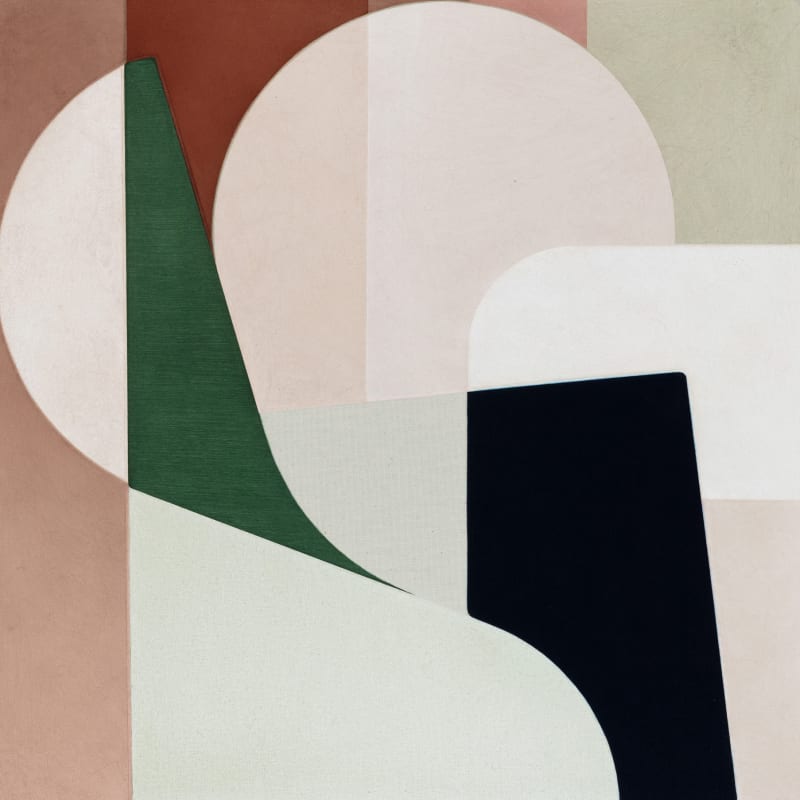616 East Hyman Avenue, Aspen, CO
For inquiries, please contact Senior Director Kelly Woods:
Marianne Boesky Gallery is pleased to present Curious Geometries, an exhibition of new works by Sanford Biggers, Svenja Deininger, Sarah Meyohas, and Claudia Wieser at the gallery’s Aspen space. Throughout their work, Biggers, Deininger, Meyohas, and Wieser all examine notions of the geometric, drawing on pattern and contour to think about history, space, time, and perception.
In new sculptural works from his Codex series, Sanford Biggers (b.1970; Los Angeles, CA) continues his ongoing material and conceptual exploration of African-American history and folk traditions, modes of communication, and the intersection of past and present. For the newest Codex works, Biggers produces hand-painted ceramic tiles utilizing the patterns found on antique quilts—versions of which, according to African American folkloric traditions, acted as coded signposts on the Underground Railroad. Placing the tiles within free-standing steel armature, Biggers puts the patterns of the found quilt in conversation with the insistent geometries of his sculptural forms. Through this artistic intervention, Biggers retains the visual and narrative intent of the objects’ original creators while drawing occluded histories and mythic narratives into the present and elucidating their ongoing relevance.
Driven by perpetual inquiry into the nature of her physical surroundings, Svenja Deininger (b. 1974; Vienna, Austria) builds her compositions gradually over time. Beginning each painting with a singular abstract form—drawn from a shadow or perhaps a memory—Deininger puts down layer upon layer of primer, paint, and varnish on canvas before carefully stripping them back to reveal sections of opaque color and raw canvas, creating curious, organic geometries. The resulting compositions masterfully deny all evidence of their making, their edges providing the only index for how the paintings were made. Seemingly materializing fully formed—without visible brushstrokes or gestures—Deininger’s intimate abstractions nevertheless possess intricately textured surfaces, producing a dynamic interplay of stillness and movement, shadow and light, color and form.
Seeking to mimic the experience of augmented reality without digitization, Sarah Meyohas (b. 1991; New York, NY) employs holographic technology first developed in the 1940s (and subsequently recognized as a unique invention in 1971, when Hungarian-British physicist Dennis Gabor was awarded the Nobel Prize in Physics for his work with holography). To create her Interference works, Meyohas records interference patterns that—when strategically lit from above—produce a three-dimensional image. Pushing the holographic medium beyond its previous uses, Meyohas combines multiple holographic masters—layered close-up imagery of plant matter—in a gem-like geometric formations, juxtaposing the rhizomatic nature of the botanical world with the rigid geometry of physics.
In a selection of new tiled mirrors and a suite of all-new drawings, Claudia Wieser (b.1973; Freilassing, Germany) deploys the formal language of Geometric Abstraction to experiment with dimension, perspective, and perception, ultimately creating for the viewer an experience of optical ambiguity. Inspired by the spirituality of 20th-century Modernists—Paul Klee and Wassily Kandinsky, among others—Wieser broadens those artist's ideals to consider abstraction’s coexistence with physiological experience. In her meticulous, colored-pencil and gold-leaf drawings, the artist’s hand is readily evident as her delicate mark-making process coalesces into radiant, meditative compositions. With her ceramic-tiled mirrors, Wieser—who is equally fluent in the language of craft—plays the optics of space, making the viewer an active participant in her geometric experimentations.
Alongside Curious Geometries, Marianne Boesky Gallery is pleased to present a selection of new work by Allison Janae Hamilton (b. 1984; Lexington, KY), opening July 30. Throughout her practice, Hamilton draws on her upbringing in the rural American South, weaving themes of environmental justice, folklore, mythology, and the contemporary legacies of colonization and enslavement into sculpture, painting, photography, and video work. Layering plant matter, landscape and figurative imagery, complex sounds, and animal remains throughout her work, Hamilton creates immersive spaces that consider notions of “Americana” and our relationships to land in the face of a changing climate, particularly in the rural American South.





